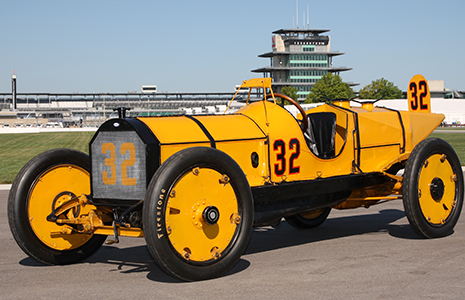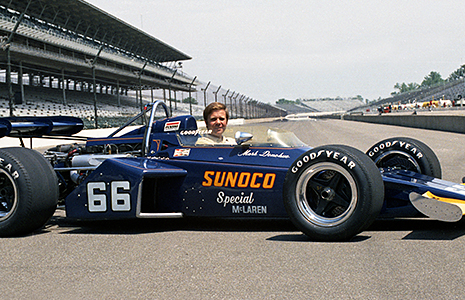Hildebrand leading primal effort to honor car numbers
JUN 16, 2017
JR Hildebrand calls himself a numbers guy, but not in the way you’d think of someone who became a National Merit Scholar in high school and was accepted into an MIT engineering program.
Hildebrand, who shunned college to become a professional race driver, is a straight-A student of car culture. When he’s not powering his way around a track as a driver for Ed Carpenter Racing, he often turns his fascination to the styling of historic race cars, especially hand-painted designs and, particularly, car numbers.
“The design of the cars, not only from a manufacturing and engineering perspective but also the artistic design of the paint schemes and logo placement and numbers, has always been interesting to me,” said the 29-year-old Hildebrand, who’s in his eighth season in the Verizon IndyCar Series but only third full time. “To me, the history of our sport is a currency that’s free to us within the sport. There’s so much cool stuff and it really tells the story of where we are now in a lot of ways.”
Hildebrand began telling that story in May with the launch of an online project called “#PrimalNumbers” (https://medium.com/primalnumbers). It’s the outgrowth of conversations he had with a few car-geek friends – Reilly Brennan, Diego Rodriguez and Clay Dean – who would discover cool stuff and share photos and thoughts with each another online.
What Hildebrand and his buddies learned was that car numbers were really cool, sometimes quirky, and often altered as the old racers were repaired or restored.
 Their first post in early May covered the No. 32 Marmon Wasp, winner of the first Indianapolis 500 with driver Ray Harroun in 1911.
Their first post in early May covered the No. 32 Marmon Wasp, winner of the first Indianapolis 500 with driver Ray Harroun in 1911.
“It started about six or eight months ago with all of us kind of privately sharing pictures with each other of awesome race cars,” Hildebrand said. “We were working on some Indy car-related stuff on a side project and Reilly thought it would be cool to have the Marmon Wasp’s number digitally recreated. He had the ‘32’ made and we all instantly jumped on the bandwagon.
“We knew we wanted to make this a thing and not just have it for ourselves; write a little summary both from a historical perspective with the race cars and also from a design perspective. Where do these numbers come from, why are they meaningful and what makes them unique?”
Along the way, Hildebrand noticed that many of the numbers on restored cars didn’t match the original design in old photos (notice the difference in the numbers on the Marmon Wasp between the photo taken above in 1911 and the one of the restored car at right). It bothered him how much detail went into the meticulous resurrection in most other areas of the cars, while the numbers seemed an afterthought.
“We realized that a lot of these numbers aren’t restored properly when everything else about a lot of old race cars gets restored right down to the millimeter,” he said. “The numbers, for some reason, get missed as an important part of that process.”
Hildebrand’s write-up on the Marmon Wasp noted how the number – 32 – changed in style over the years. The car now shows block numerals with square edges, whereas the original featured “32” with more flare – the tips of the numerals angled to show “an almost medieval look to the design,” as he described it in his #PrimalNumbers report.
“I look at a lot of historic race cars. Sometimes they get over-restored to a spec that was never that clean, never that perfect or with paint that was never quite that good,” Hildebrand said. “The digital photo library that Indianapolis Motor Speedway has, let alone a lot of other libraries or archives of photos, can show you exactly how they used to be.
 “On race cars now, everything is just over-laid on a piece of CAD software. There’s so much more to appreciate about great hand-lettering and hand-painted numbers on the old cars, and there’s a finesse even to how sponsor names are over-laid on the curvature of a car. There’s some creative or artistic license that needs to be taken to sort of get that right and make it look proper. That’s always been interesting to me.”
“On race cars now, everything is just over-laid on a piece of CAD software. There’s so much more to appreciate about great hand-lettering and hand-painted numbers on the old cars, and there’s a finesse even to how sponsor names are over-laid on the curvature of a car. There’s some creative or artistic license that needs to be taken to sort of get that right and make it look proper. That’s always been interesting to me.”
Hildebrand and his friends also wrote about the Roger Penske Lola that Mark Donohue drove at the Indianapolis 500 in 1969, citing the unique qualities of the number – 66 – on that car. The number on the left side, he said, didn’t always match exactly the number on the right side.
“When you dig into the archives, you can see that the number on the left side of the car changed multiple times just over the course of the month of May at Indianapolis that year,” he said.
Hildebrand is a big Mark Donohue fan – the first racing book he read as a kid was Donohue’s “The Unfair Advantage” – and he’s smitten with the No. 6, which Donohue carried on his cars most of his career outside of Indy cars.
“I felt fortunate to have the No. 6 on my cars a couple of years at Indy,” Hildebrand said. “The cleanest I’ve seen was the Donohue Penske ‘66’ from his ’72 Indy winner and the ‘6’ alone on the (Porsche) 917/30 Can-Am car. They’re sort of clinical like you would expect a Penske number to be.”
The #PrimalNumbers project also detailed the No. 9 Salih Belond Special (below) that Sam Hanks drove to victory at Indianapolis in 1957. Future installments will also feature endurance sports cars. Besides the written history lesson, #PrimalNumbers also offers period-correct art of race car numbers that readers can download.
“For those of us who are racing nerds, we thought providing something that can be digitally shared for people to re-use however they want would be a fun thing to do,” Hildebrand said. “We've seen some really cool stuff – people using them on their home screens, their phone backgrounds and stuff like that.”
The reader response has made Hildebrand realize how many others are passionate about the history of the sport, even when the details are boiled down to car numbers.
“For us, it's a fun project that we would keep doing even if nobody thought it was cool,” he said. “But it’s definitely neat to see that people are using it and enjoying it. You don’t have to be a numbers person, you don’t have to be a math or science kind of person. You really just have to respect and appreciate where our sport has been, its important cars and important people.”























